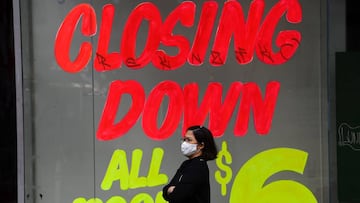US recession began in February: what it means and how many have there been?
With the National Bureau of Economic Research confirming that the United States has entered a recession, we look behind the economic downturns.


It can sometimes take over a year for the National Bureau of Economic Research (NBER) to announce that a recession has begun. But after just a handful of months, the unprecedented situation that we have seen with the coronavirus pandemic has provided enough evidence for them to state that February 2020 was the beginning of the current downturn in the United States.
What is a recession anyway?
A recession is traditionally defined as a period of two consecutive quarters, or six months, where there has been negative economic growth. That said, in the US it is defined by the NBER as "a significant decline in economic activity spread across the economy, normally visible in production, employment, and other indicators."
The NBER adds to that definition further by saying that a recession starts “when the economy reaches a peak of economic activity” and it ends “when the economy reaches its trough.” This is why the organisation has chosen to put February as the date when we saw the economic expansion from back in June 2009 come to an end, following a record run of 128 months.

How many recessions have there been in the US?
In total there have been 47 recessions in the United States, and these date back to the Articles of Confederation. In saying that, experts have argued about several of those across the 19th century and as Robert Whales wrote, “the current consensus is that the volatility of GNP and unemployment were greater before the Great Depression than they have been since the end of World War II.”
Therefore, considering US recessions since WWII, there have been 12. Each of these has lasted around ten months on average - compared to an average of 57 months for the expansion periods in between, prior to stand out period mentioned above.
Will I be able to receive my payment next year?
What do Americans think of a second round of payments?
Will I receive a replacement debit card if I threw the first one out?
Post-World War II recessions
The first post-War recession came in the aftermath of the battles, and ran from February to October of 1945 as troops returned home and military contracts were cancelled. That was followed at the end of 1948 with another recession as consumer spending slowed down and lasted almost a year before expansion was seen.
The others came and went sparked by a variety of reasons: July 1953 to May 1954: Post-Korean War Recession; August 1957 to April 1958: Asian Flu Pandemic; April 1960 to February 1961: The Recession that Cost Nixon an Election; December 1969 to November 1970: Putting the Brakes on 1960s Inflation; November 1973 to March 1975: The Oil Embargo; January to July 1980: Second Energy Crisis and Inflation Recession; July 1981 to November 1982: Double Dip Recession; July 1990 to March 1991: S&L Crisis and Gulf War Recession; March to November 2001: The Dot-Com Crash and 9/11.
Related stories
Then arrived the final recession prior to the one we are now faced with, known as The Great Recession. Running from December 2007 to June 2009, this was the longest and hardest to have hit the country since the Great Depression and had been triggered by the global financial crisis as the housing bubble dramatically burst.
Further information about the post-WWII recessions.

